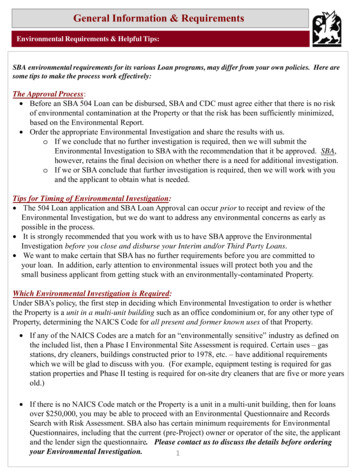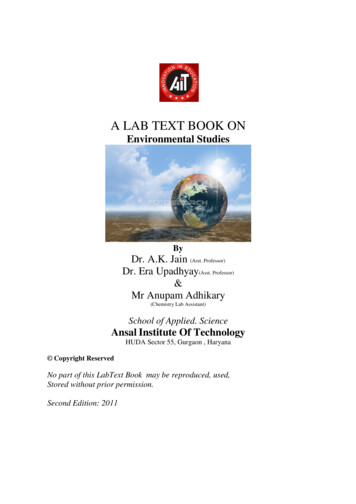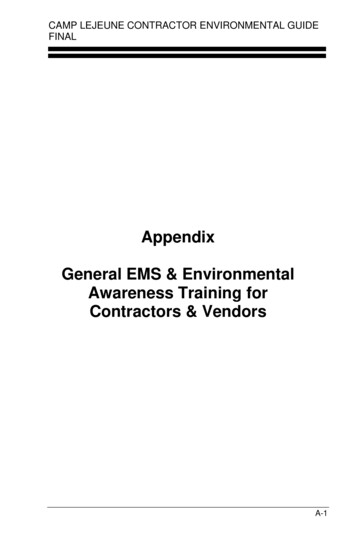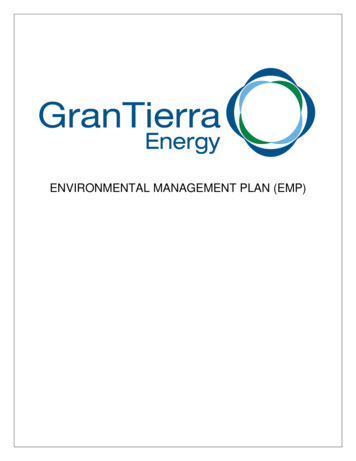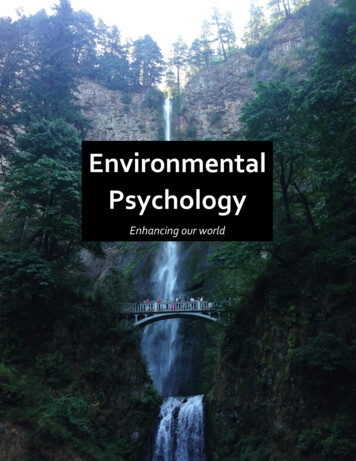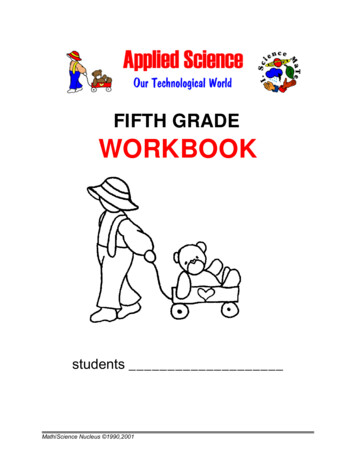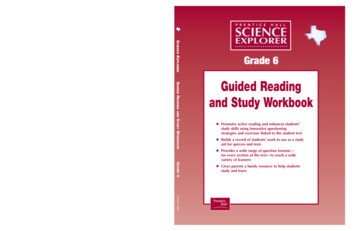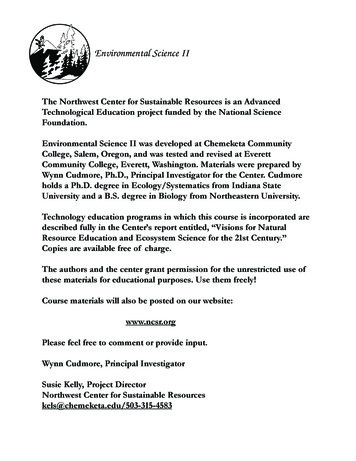
Transcription
Environmental Science IIThe Northwest Center for Sustainable Resources is an AdvancedTechnological Education project funded by the National ScienceFoundation.Environmental Science II was developed at Chemeketa CommunityCollege, Salem, Oregon, and was tested and revised at EverettCommunity College, Everett, Washington. Materials were prepared byWynn Cudmore, Ph.D., Principal Investigator for the Center. Cudmoreholds a Ph.D. degree in Ecology/Systematics from Indiana StateUniversity and a B.S. degree in Biology from Northeastern University.Technology education programs in which this course is incorporated aredescribed fully in the Center’s report entitled, “Visions for NaturalResource Education and Ecosystem Science for the 21st Century.”Copies are available free of charge.The authors and the center grant permission for the unrestricted use ofthese materials for educational purposes. Use them freely!Course materials will also be posted on our website:www.ncsr.orgPlease feel free to comment or provide input.Wynn Cudmore, Principal InvestigatorSusie Kelly, Project DirectorNorthwest Center for Sustainable Resourceskels@chemeketa.edu/503-315-4583
Table of ContentsEnvironmental Science IICOURSE OUTLINE.1LABS & ACTIVITIESECOSYSTEM MANAGEMENT AN OVERVIEW.10NOTES FOR INSTRUCTORS.17SOILS I/PHYSICAL & BIOLOGICAL ANALYSIS.24NOTES FOR INSTRUCTORS.32SOILS II/ANALYSIS & APPLICATION.34NOTES FOR INSTRUCTORS.42BIODIVERSITY I/FIELD TRIP WILDLIFE REFUGE.44NOTES FOR INSTRUCTORS.48BIODIVERSITY II/NORTHERN SPOTTED OWL HABITAT ASSOCIATIONS.57BIODIVERSITY III/CALIFORNIA CONDORS CASE STUDY.62AMERICAN INDIAN CULTURAL PRESPECTIVES CONDORS.65SUPPLEMENTAL INFORMATION CALIFORNIA CONDORS.72NOTES FOR INSTRUCTORS.73A BRIEF HISTORY OF ATLANTIC COD.77BIODIVERSITY IV/PACIFIC NORTHWEST SALMON COMPLEX ISSUES.79NOTES FOR INSTRUCTORS . 88TRIBAL LAND MANAGEMENT.89DENDROCHRONOLOGY.90NOTES FOR INSTRUCTORS .98THE CAPITAL PRESS AS A RESOURCE FOR ENVIRONMENTAL SCIENCE.101STUDENT ASSESSMENTSSTUDY GUIDE EXAM #1.103STUDY GUIDE EXAM #2.105STUDY GUIDE FINAL EXAM.107EXAM #1 WINTER 2000.109EXAM #2 WINTER 2000.116
Environmental Science IICourse OutlineEnvironmental Science II4 Credits 3 hours lecture, 3 hours labINTRODUCTION TO ENVIRONMENTAL SCIENCEEnvironmental Science was developed at Chemeketa Community College as a sequence of threecourses that addresses environmental topics. Each 4-credit course requires a 3-hour lab that meetsonce per week and 3 hours of lecture. The courses are targeted towards several audiences including: students in natural resource areas (e.g., Forestry, Fish and Wildlife, agriculture)transfer students in areas other than biology who need a lab science course orsequencebiology majors who wish to broaden their background in environmental biologyanyone interested in learning more about environmental issuesI consider the courses to be “Environmental Science for the Citizen,” and emphasis is placed onthose concepts and issues that in my judgement should be understood by all citizens. The approachis science-based, and a distinct effort is made to present opposing viewpoints in contentious environmental issues. The three-term sequence was added as a requirement for students in the ForestResources Technology Program at Chemeketa, where it serves primarily to introduce students tobasic ecological concepts and environmental issues that relate to natural resource management. Thefollowing goals have been established for the sequence:ØØØØØØØØØØØintroduce students to science as a “way of knowing”introduce students to basic ecological conceptsintroduce students to environmental problems at local, national and global scaleswork cooperatively in small groupscommunicate effectively in written and oral formatsapply appropriate technology to scientific explorationaccess and use supplemental information relevant to course topicsengage students in hands-on, field and laboratory experiences that require criticalthinkinguse ecosystem management as a major theme in natural resource managementintroduce students to societal aspects of environmental issuesapply mathematical concepts to scientific inquiry1CourseOutline
This document describes several laboratory activities that have been developed for EnvironmentalScience II in an attempt to meet these general goals. It is my hope that others who have similar goalsfor related courses will find them useful.TEXT: Botkin, D. and E. Keller. 2000. Environmental Science: Earth as a Living Planet. 3rd ed. JohnWiley and Sons, Inc. New York. 649 pp.COURSE DESCRIPTION:The primary goal in Environmental Science II will be to familiarize students with environmentalproblems associated with biological resources. Ecosystem management will be used as an underlyingtheme to evaluate issues concerning resource use and management such as food production, deforestation, fisheries management, soil erosion, water-related issues, and the loss of biodiversity. Additionally, the impacts of global climate change on biological resources will be examined.PREREQUISITEEnvironmental Science I or General Biology or permission of instructor.COURSE OBJECTIVESUpon successful completion of the course, students should be able to:1. Measure environmental variables and interpret results2. Evaluate local, regional and global environmental topics related to resource use andmanagement3. Propose solutions to environmental problems related to resource use and management4. Interpret the results of scientific studies of environmental problems5. Describe threats to global biodiversity, their implications, and potential solutionsSTUDENT ASSESSMENTGrades are based on a point system with an approximate breakdown as follows:Exam #1Exam #2Final ExamLabsArticle reviews2CourseOutline100 points100 points100 points125 points25 points450 points
The term s grade is based on a percentage of total points accumulated according to the followingschedule:90 - 100 %80 - 89 %70 - 79 %60 - 69 % 60 %ABCDFREADING SCHEDULE (BOTKIN AND KELLER, 2000)WEEKCHAPTERTOPICS1Chap. 10Chap. 11Chap. 10Chap. 11Chap. 12Chap. 12Chap. 13Chap. 13Chap. 19Chap. 19Chap. 21Chap. 21World Food SupplyEffects of Agriculture on the EnvironmentWorld Food SupplyEffects of agriculture on the EnvironmentWild Living Resources: Plentiful and EndangeredWild Living Resources: Plentiful and EndangeredLandscapes and SeascapesLandscapes and SeascapesWater Supply, Use and ManagementWater Supply, Use and ManagementThe Atmosphere, Climate and Global WarmingThe Atmosphere, Climate and Global WarmingFINAL EXAM234567891011PLEASE NOTE:1.In addition to text readings, students are required to read selected articles in the Capital Presson a regular basis. The Capital Press is a weekly regional agricultural newspaper that regularlycovers natural resource management issues (See pp. 101-102).2.From time to time additional readings will be assigned to supplement reading material in thetext. These are generally provided for students as handouts and used for class discussion.3CourseOutline
TOPICSI.Measurements of Human Impact on EcosystemsA.B.C.D.Local to global scalesDirect vs. indirect impactsMethods of imaging (aerial photography, satellite imagery, GIS)Ecological footprint analysisII.Natural Resource Management approachesA. Sustained yield/multiple useB. Ecosystem management1. Elements and goals2. Examples of implementationIII.Agricultural EcosystemsA. World food supplyB. Agricultural vs. natural ecosystemsC. History of agricultureD. Impacts of agricultural systems on the environment1. Impacts on soils2. Impacts on water resources3. Impacts on native plants and animals4. Impacts on global systemsE. Physical and biological characteristics of soilsF. Sustainable agriculture1. Elements and goals2. Integrated pest management3. Precision agriculture4. Role of genetically engineered crops5. Incorporation of agroecosystems into landscapes6. Societal aspects (government policies, economics, etc.)IV.Wildlife ResourcesA. Definitions of “wildlife”B. Loss of Biodiversity1. Measures and evidence for extinction2. Causes and consequences of extinction3. Endangered Species ActC. Wildlife management1. Goals2. GAP analysis, wildlife refuges and other efforts3. Cores, buffers and corridors4. Species management vs. ecosystem management5. Maximum sustainable yield vs. optimum sustainable yield4CourseOutline
V.Fisheries ResourcesA. Types and importance of fisheries resourcesB. Status of global fisheries resourcesC. Fisheries management1. Case studies - anchovy, salmon, atlantic cod2. Ecological restoration efforts3. Hatchery programs and aquaculture4. Optimum vs. maximum sustainable yield5. Application of ecosystem management6. Population biology and genetics7. Fisheries legislationVI.Forest ResourcesA. Types and importance of forest resources1. Human goods and services2. Ecosystem servicesB. DeforestationC. Forest management1. Multiple use and sustained yield2. Definitions of sustainability3. Old growth forest characteristics and management4. New approachesC“New Forestry,” FEMAT, etc.VII.Water ResourcesCSupply, Use and ManagementA. Types and status of resourcesB. Water use and conservationC. Watershed managementD. Stream and river ecosystems1. Role of riparian zones2. Role of organic input3. Stream food webs4. Flood ecologyE. Wetlands1. Ecological roles2. Wetland mitigation3. Everglades Restoration ProjectCa Case StudyVIII.Global WarmingA. Atmosphere and climateB. Causes of “The Greenhouse Effect”C. Evidence of global warmingD. Biological effects of global warming1. Impacts on forests2. Impacts on agriculture3. Impacts on fisheries and wildlifeE. Solutions and current efforts5CourseOutline
LABORATORIES & ACTIVITIESEcosystem ManagementCan OverviewSustainable AgricultureSoils I: Physical and Biological AnalysisSoils II: Analysis and ApplicationsBiodiversity I: Wildlife refugesCField Trip to Baskett Slough Wildlife RefugeBiodiversity II: Habitat DeterminationCNorthern Spotted Owl Habitat AssociationsBiodiversity III: California Condor Case Study/American-Indian PerspectivesBiodiversity IV: Pacific Northwest SalmonCComplex Issues* See note belowTribal Land Management: Field Trip to Grand Ronde Stream Restoration ProjectDendrochronologyCIntroduction and ApplicationsWeekly assignments: Capital Press article reviews and discussionL Important Note: students will need lead time for the salmon issue lab. Please refer to labintroduction well before its delivery to alert students to pre-lab assignments.6CourseOutline
Environmental Science II Detailed ScheduleDateTopic/ActivityWeek 1Lecture 1 C Course Introduction, Syllabus, Text discussion, CurrenttopicsLecture 2 C Human Impacts on Ecosystems/Ecological Footprint analysisLecture 3 C Introduction to agricultureLAB #1 Overview of Ecosystem Management (lecture/readings/videotapepresentation)Week 2Lecture 4 C History of agriculture /Traditional vs. Sustainable agricultureLecture 5 C Physical and Biological aspects of SoilLecture 6 C Physical and Biological aspects of Soil/Impacts of agricultureon Natural SystemsLAB #2 Sustainable agricultureWeek 3Lecture 7 C Impacts of agriculture on Natural Systems/Sustainable agricultureLecture 8 C Elements of Sustainable agriculture/Video-“High Tech agriculture”Lecture 9 C Elements of Sustainable agricultureLAB #3 Soils Lab ICPhysical and Biological Characteristics of SoilsWeek 4Lecture 10 C Introduction to WildlifeLecture 11 C EXAM #1Lecture 12 C Endangered Species/BiodiversityLAB #4 Soils Lab IICPhysical and Biological Characteristics of Soils7CourseOutline
Week 5Lecture 13 C Endangered species/Biodiversity/Wildlife ManagementLecture 14 C Wildlife Management “What’s being done?”Lecture 15 C Endangered Species Act DiscussionLAB #5 Biodiversity I: Field Trip to Baskett Slough Wildlife RefugeWeek 6Lecture 16 C Introduction to ForestryLecture 17 C Forest Management on Private Lands (Forest Industry Video)Lecture 18 C Forest Management on Public Lands/Old Growth ForestCharacteristicsLAB #6 Biodiversity II: Condor Video and Biodiversity SlidesWeek 7Lecture 19 C Old Growth Forest Characteristics/Spotted Owl activityLecture 20 C Old Growth Forest Management/Wind River Canopy CraneVideoLecture 21 C Introduction to FisheriesLAB #7 Salmon Presentations IWeek 8Lecture 22 C Status of FisheriesLecture 23 C Fisheries ManagementLecture 24 C EXAM #2LAB #8 Salmon Presentations IIWeek 9Lecture 25 C Water Resources and ManagementLecture 26 C Water Resources and Management/Flood EcologyLecture 27 C Everglades Ecological Restoration Project/Wetland MitigationLAB #9 Field Trip to Grand Ronde Stream Restoration Project8CourseOutline
Week 10Lecture 28 C Global Warming/Greenhouse EffectLecture 29 C Biological Impacts of Greenhouse EffectLecture 30 C Biological Impacts of Greenhouse Effect/Summary of TermLAB #10 Dendrochronology/Global WarmingWeek 11FINAL EXAM9CourseOutline
Environmental Science IIEcosystem ManagementAn OverviewEcosystem ManagementAn OverviewINTRODUCTIONAs we have consumed, exploited and manipulated natural resources for human use (food production, lumber production, mining, recreation, etc.), it has become obvious that the resources we valuedo not exist in isolationCrather, they are part of larger systems. In these systems, each componentplays an important role. It may be argued that to maintain the integrity of these systems, the Abestmanagement is no management.@ However, given that we will continue to manipulate natural andartificial ecosystems, it is in our best long-term interest to do so in a manner that assures (or at leastimproves the likelihood of) the integrity of those systems. Ecosystem Management (EM) hasbeen proposed as a mechanism that strives to achieve this goal and will be used as a recurring themein this course.The concept of EM is currently under development. It has been labeled everything from an oxymoron to a guiding principle that will Aprotect the environment, maintain healthy ecosystems, preservebiological diversity, and ensure sustainable development@ (Lackey, 1995). The concept has led toantagonism from pro-development interests who see it as a smoke screen by environmentalists topreserve more acreage in its natural state. Nevertheless, the U.S. Forest Service and the Bureau ofLand Management adopted EM as their guiding philosophy in 1992, and 16 additional federalagencies and departments in 1993 did the same. At the very least it appears that ecosystem management provides some options or insurance for the future that may not be available under othermanagement philosophies. Attempts to apply EM on a large scale include the President s (Northwest) Forest Plan (Option 9) in the Pacific Northwest and the Everglades Ecosystem Project inFlorida. The concept has achieved a great degree of acceptance in scientific, socioeconomic andpolitical circles and it appears, at least for now, that Aecosystem management represents our bestopportunity to describe, understand and fit in with the natural world@ (Grumbine 1994).10EcosystemMgmt
WHAT IS ECOSYSTEM MANAGEMENT?Ecosystem management attempts to:ØØØØØmaintain existing biodiversity at genetic, species and ecosystems levelsmaintain evolutionary and ecological processes within ecosystemsmaintain or enhance long-term productivity of ecosystemsmanage over temporal and spatial scales that are appropriate for the ecosystemaccommodate human uses within these constraintsA sampling of definitions of EM by various authors:AEcosystem management integrates scientific knowledge of ecological relationships within a complex sociopolitical and values framework toward the general goal of protecting native ecosystemintegrity over the long term.@ Grumbine (1994)AEM is an approach to the management of natural resources that strives to maintain or restoresustainability of ecosystems and to provide present and future generations a continuous flow ofmultiple benefits in a manner harmonious with ecosystem sustainability.@ Unger (1994) AssociateChief of U.S. Forest ServiceAProtecting or restoring the function, structure and species composition of an ecosystem, recognizing that all components are interrelated.@ U.S. Fish and Wildlife ServiceAEM is a process that considers the total environment. It requires the skillful use of ecological,economic, social, and managerial principles in managing ecosystems to produce, restore, or sustainecosystem integrity and desired conditions, uses, productivity, values, and services over the longterm. EM recognizes that people and their social and economic needs are an integral part ofecological systems.@ U.S. Bureau of Land Management (1993)SOME UNDERLYING PRINCIPLES AND IMPLICATIONSEcosystem management has ecosystem science at its core. This includes concepts such asinterconnectedness of ecosystem components, biodiversity, nutrient cycling, energy flow, populationgrowth, limiting factors, species interactions, competition, symbiosis, etc. Ecosystem managementwill require unprecedented cooperation between various parties (public and private) responsible forstewardship of various land holdings since management will be based on ecological rather than politicalboundaries.11EcosystemMgmt
Ecosystem management requires thorough understanding of the ecosystems we are managing.Adaptive management recognizes that our knowledge of ecosystems is incomplete and usesmanagement as an ongoing process to gain further understanding of our impact on complex systems. A close working relationship between Amanagers@ and Aresearchers@ assures that managementactivities incorporate the latest scientific information and that management activities will be updatedon an ongoing basis as our understanding of ecosystems improves. A close working relationshipbetween researchers and managers is of mutual benefit. Managers gain access to state-of-the-artinformation on the systems they are managing. Researchers gain feedback that fine tunes the focusof scientific studies and provides them with a better understanding of the practical difficulties facedby managers. The results of management activities are monitored continually, providing a feedbackloop to managers. Management practices can, therefore, be adjusted as we learn of inadequacies ormistakes.Ecosystem management goals are socially defined. People must be recognized as an integral component of ecosystems. Human values will play an important role in defining the goals of ecosystemmanagement. This may be the most problematic component of EM, for even if we gain the scientificknowledge to manage ecosystems sustainably, conflicting societal goals and human values mayprevent this from happening. There is evidence to suggest that some interests are using this aspectof EM to justify Abusiness as usual@; e.g., short-term, single-commodity based management withminimal regard for ecosystem integrity.Where is Ecosystem Management Being Discussed, Implemented or Practiced?ØØØØØEcosystem management has been a major theme at national and international conferencesincluding the Seventh American Forest Congress (1996) and the Canadian Institute of ForestryAnnual Meeting (1996).Journal of Forestry has published a number of major articles on ecosystem management andadaptive management in recent issues. Articles in the February and June 1996 issues addressEM in non-industrial private forests.Boise Cascade Corporation is developing a plan for management of an 300,000 acre area inMinnesota that will be used as a demonstration project for ecosystem management. Anotherdemonstration project is planned by Boise Cascade in Idaho.Implementation of ecosystem management in large rivers and floodplains is addressed in aseries of articles in BioScience: 45(3).Some examples of projects that are being presented as attempts to implement ecosystemmanagement: 12EcosystemMgmtClayoquot Sound, Vancouver, British ColumbiaEastside Ecosystem Management ProjectCEastern WashingtonColumbia Basin Ecosystem Management ProjectPresident s Forest PlanCOption 9 (Northwest Forest Plan)Greater Yellowstone EcosystemEverglades Restoration ProjectCFloridaWildlands ProjectCNorth America
ØThe U.S. Forest Service adopted EM as a major emphasis in 1993. Concepts of EM are beingimplemented on National Forests across the United Sates.Sustainability, and Applications of Ecosystem ManagementEM and sustainability are closely aligned. The term generally refers to longterm economic, environmental, and community health. It was popularized in the 1992 AEarth Summit,@ and sustainabilitywas defined in the World Commission on Environment and Development s 1987 report, AOurCommon Future,@ as: Meeting the needs of the present generation without jeopardizing the ability of futuregenerations to meet their own needs.I have listed below some natural resource emphasis areas where EM is important. The termsustainability is a frequent component of these topics and the margins between EM and Asustainabledevelopment,@ Asustainable forestry,@ Asustainable agriculture,@ etc., often blur. This might provide astarting point for application components of EM.FORESTRY. In forest ecosystem management, the products taken from the system are an importantsecondary objective. Integrity of the forest ecosystem comes first. Ecosystem management wouldidentify forest sustainability as the foremost goal of national forest management, and use the conservation of biodiversity as the mechanism to that end.AGRICULTURE. Sustainable agriculture is a systems-level approach to understanding complexinteractions within agricultural ecosystems. It produces adequate amounts of high quality food whileprotecting other resources by using practices that are both environmentally safe and profitable. Asustainable farm relies as much as possible on beneficial natural processes and renewable resourcesdrawn from the site itself. Integrated pest management and holistic agriculture are examples of itsapplication.FISH & WILDLIFE. The conservation of wildlife and fish populations is achieved by practicingecosystem management. Maintaining the system over the long term protects species which dependon it. Applications and examples of incorporating systems-based management and conservationapproaches include GAP analysis, application of island biogeography theory to wildlife management, establishing minimum critical size for ecosystem studies, providing wetland and riparian bufferprotection and ecological preserve designs; i.e., core reserves, buffers and corridors.Ecosystem Management: Current ResourcesA number of authors have published articles that define ecosystem management and describeattempts to implement it. The following articles are representative of some of these publications.Educators interested in incorporating ecosystem management into the curriculum should find theseto be valuable resources.13EcosystemMgmt
Books & Publications1.Grumbine, R.E. 1994. What is ecosystem management? Conservation Biology 8(1):27-38.An excellent article used for many of the Center s (and my) original materials.2.Nielsen, L.A. and D.J. Decker. 1995. Educating natural resource professionals for ecosystem management.Renewable Resources Journal. Spring 1995:12-17.This article addresses some of the issues concerning the preparation of natural resource workers in a world whereecosystem management is implemented.3.Seastedt, T. 1996. Ecosystem science and society. BioScience 46(5):370-372.4.Several authors. 1996. Ecological Applications 6(3)This issue contains a series of articles from a number of authors who describe their insight on ecosystemmanagement. Authors include representatives of the wood products industry, universities and federal agencies.5.Kohm, K.A. and J.F. Franklin (eds.) 1997. Creating a forestry for the 21st century: the science of ecosystemmanagement. Island Press, Washington, D.C. 475 pp.This book addresses ecosystem management as it applies to forestry. It represents the first attempt to placeecosystem management in an Aoperational context@; i.e. from theory to practice.6.Christensen, N.L. 1996. The scientific basis for ecosystem management: an assessment by the Ecological Societyof America. Ecological Applications 6: 665-691.This document is available via e-mail. You can order a copy at esahq@esa.org7.LaRoe, E.T., et al. 1995. Our living resources: A report to the nation on the distribution, abundance andhealth of U.S. plants, animals and ecosystems. U.S.D.I. National Biological Service, Wash., D.C. 530 pp.This report is the first comprehensive publication to come out of the biological science branch of the Departmentof the InteriorCthe National Biological Service. It is a large collection of short articles that addresses mostbiological resource issues in the United States. GIS- generated maps and data summaries are found throughoutthe document. I have found it to be a valuable resource and a good starting point for researching any biologicalresource issue. It is available from the Superintendent of Documents, U.S. Government Printing Office, Washington, D.C. 20402; Stock # 024-010-00708-714EcosystemMgmt
8.Baker, J.P. et al. 1995. Ecosystem management research in the Pacific NorthwestCfive year research strategy.U.S. Environmental Protection Agency, Corvallis, OR. 251 pp.This report outlines EPA’s view of ecosystem management and describes this agency s plan for implementation inthe Pacific Northwest. The document number is EPA/600/R-95/069 and it is available from:Western Ecology DivisionNational Health and Environmental Effects Research LaboratoryU.S. Environmental Protection Agency200 SW 35th StreetCorvallis, OR 973339.Logan, R.S. and R.A. Fletcher. 1996. Forest Ecosystem Stewardship. Montana State UniversityExtension Service #EB141. 49 pp.This document describes current thinking on forest ecosystem management to a person without an extensivebackground in forestry or ecosystem science. Jargon is kept to a minimum, yet the most important ecosystemprinciples are introduced, defined and examples are given. The use of Aecosystem science@ as a basis for naturalresource management is a dominant theme. There is a good balance between principles/theory and practical,Ahow to@ information that could be applied by a timber owner. The document represents a good approximationof the level of understanding of EM for students in natural resources technician programs.10. Oliver, C. 1996. Forest Ecosystem Management: A Graphic Overview. Boise Cascade Corporation,LaGrande, Oregon. 52 pp.This document is a bit more technical than Logan and Fletcher (1996) and addresses ecosystem management onindustrial forests. It contains a wealth of information and flashy graphics to illustrate major points. The mainelements of ecosystem management are addressed in the documentCmaintaining biodiversity, ecological processes,and site productivity while managing on larger scales of time and space and meeting human needs. Expectedly,there is a clear emphasis on the latter and the message of meeting the social and economic need of humansreceives priority.11. Yaffee, S.L., A.F. Phillips, I.C. Frentz, P.W. Hardy, S.M. Maleki and B.E. Thorpe.1996. Ecosytemmanagement in the United States: An assessment of current experience. Island Press, Washington, D.C.352 pp.This publication is a collaborative effort of the University of Michigan and the Wilderness Society. Using thedefinition proposed by Grumbine (1994), the authors examine in detail 105 ecosystem management projectsthroughout the U.S. General characteri
TEXT: Botkin, D. and E. Keller. 2000. Environmental Science: Earth as a Living Planet. 3rd ed. John Wiley and Sons, Inc. New York. 649 pp. COURSE DESCRIPTION: The primary goal in Environmental Science II will be to familiarize students with environmental problems associated with biologic

